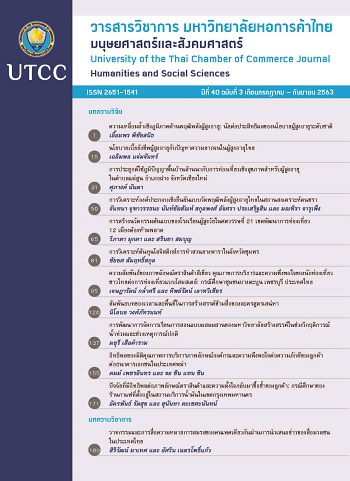Regional Inequality in Active Ageing: Implications on the Effectiveness of National Ageing Policies
Main Article Content
Abstract
This research displays regional policy gap. Similar to many countries which encounter ageing society, Thailand implemented policies that seek to promote active ageing in the elderly population. However, in most cases, policy formulation at the national level relies on macroeconomic variables, assuming "One-Size-Fits-All". The regional characteristics and inequality in active ageing can be reflected by the Active Ageing Index (AAI) and the Gini (AAI) coefficient in this research. The analysis mainly employs the Survey of Elderly Population in Thailand in 2014 and 2017 from the National Statistical Office. The finding indicates that at the national level, AAI has decreased and Gini (AAI) has increased. Overall, AAI and Gini (AAI) are negatively correlated, which is in line with most international findings. The research raises an example of evaluating the effectiveness of a national policy to promote elderly employment. It is found that the group of provinces with increased elderly employment level has lower AAI inequality than that with reduced elderly employment level. The inequality in all aspects of active ageing has the tendency to increase in the future, alike inequality in other dimensions in the country. This will further undermine the overall effectiveness of the policy at the national level. Policy-wise contribution, the indicators provided in this research can be considered as a guideline in the priority setting of regional or local supplementary ageing policies to increase the overall effectiveness of the national policy.
Article Details
ลิขสิทธิ์ของบทความ
ผลงานที่ได้รับการตีพิมพ์ถือเป็นลิขสิทธิ์ของมหาวิทยาลัยหอการค้าไทย ห้ามมิให้นำเนื้อหา ทัศนะ หรือข้อคิดเห็นใด ๆ ของผลงานไปทำซ้ำ ดัดแปลง หรือเผยแพร่ ไม่ว่าทั้งหมดหรือบางส่วนโดยไม่ได้รับอนุญาตเป็นลายลักษณ์อักษรจากมหาวิทยาลัยหอการค้าไทยก่อน
References
นฤมล บุญแต่ง. (2558). การแบ่งภูมิภาคทางภูมิศาสตร์. สืบค้นเมื่อ 6 มกราคม 2563, จาก http://www.royin.go.th/?knowledges=การแบ่งภูมิภาคทางภูมิศe
ศุภเจตน์ จันทร์สาส์น. (2555). พฤฒิพลังของผู้สูงอายุไทย การปันผลทางประชากร และโอกาสทางเศรษฐกิจของประเทศไทยในสังคมสูงวัย. วารสารศรีนครินทรวิโรฒวิจัยและพัฒนา (สาขามนุษยศาสตร์และสังคมศาสตร์), 4(7), 201-214.
สำนักงานสถิติแห่งชาติ. (2560). ดัชนีพฤฒิพลังสูงอายุไทย (Active Ageing Index of Thai Elderly). กรุงเทพฯ: ผู้แต่ง.
สุภจักษ์ แสงประจักษ์สกุล. (2557). วุฒิวัยของผู้สูงอายุไทย. วารสารสังคมศาสตร์ มหาวิทยาลัยศรีนครินทรวิโรฒ, 17, 231-248.
เอื้อมพร พิชัยสนิธ. (2558, ตุลาคม). สังคมสูงอายุที่พึงปรารถนากับการคลังที่สอดคล้อง: บทวิเคราะห์กรณีประเทศไทย. ใน การสัมมนาทางวิชาการประจำปี 2558 ครั้งที่ 38 เรื่อง "เหลียวหลัง แลหน้า เศรษฐกิจสังคมไทยในวาระ 100 ปี อาจารย์ป๋วย." จัดโดยคณะเศรษฐศาสตร์ มหาวิทยาลัยธรรมศาสตร์, กรุงเทพฯ.
Atkinson, B., & Marlier, E. (2010). Income and living conditions in Europe. Luxemburg: Eurostat.
Barslund, M., Von Werder, M., & Zaidi, A. (2019). Inequality in active ageing: Evidence from a new individual-level index for European countries. Ageing and Society, 39(3), 542-567.
Breza, M., & Perek-Bialas, J. (2014). The Active Ageing Index and its extension to the regional level. Host country paper, peer review on the active ageing index, Poland. Retrieved from http://ec.europa.eu/social/BlobServlet?docId=12940&langId=en
Chansarn, S. (2012). Active ageing of elderly people and its determinants: Empirical evidence
from Thailand. Asia-Pacific Social Science Review, 12(1), 1-18.
Kafkova, M. P. (2018). The Active Ageing Index (AAI) and its relation to the quality of life of older adults. In A.
Zaidi, S. Harper, K. Howse, G. Lamura, & J. Perek-Białas (Eds.), Building evidence for active ageing policies: Active ageing index and its potential (pp. 55-74). Singapore: Springer Nature.
Kalwij, A., & Vermeulen, F. (2008). Health and labour force participation of older people in Europe: What do objective health indicators add to the analysis?” Health Economics, 7(5), 619-38.
Magnavita, N. (2017). Productive aging, work engagement and participation of older workers. A triadic approach to health and safety in the workplace. Epidemiology Biostatics and Public Health, 14(2), e12436.1- e12461.8.
Myck, M. (2015). Living longer, working longer: The need for a comprehensive approach to labour market reform in response to demographic changes. European Journal of Ageing, 12(1), 3-5.
Organisation of Economic Co-operation and Development. (2006). Live longer, work longer. Paris: Author.
Parent-Thirion, A. (2014). Supporting longer working lives, Foundation Focus. Sustainable work: Toward better and longer working lives Issue 16 (December). Publications Office of the European Union, Luxembourg.
Piketty, T. (2014). Capital in the twenty-first century. Cambridge, MA: Harvard University Press.
Prasitsiriphon, O., Jeger, F., Tharachompoo, A., & Sakunphanit, T. (2013). Costing model for long-term care system in Thailand. Bangkok: Health System Research Office.
Thanakwang, K., & Soonthorndhada, K. (2006). Attribute of active ageing among older persons in Thailand: Evidence from the 2002 survey. Asia-Pacific Population Journal, 21(3): 113-135.
United Nations Development Programme. (2005). Human Development Report 2005. New York: Author.
United Nations Economic Commission for Europe. (2012). Active ageing and quality of life in old age. Retrieved March 12, 2018, from http://www.unece.org/index.php?id=30027
UNECE/European Commission. (2013). Policy brief: Introducing Active Ageing Index. N.P.: Author.
UNECE/European Commission (2015). Active Ageing Index 2014: Analytical report, Report prepared by Asghar
Zaidi of Centre for Research on Ageing, University of Southampton and David Stanton, under contract with United Nations Economic Commission for Europe (Geneva), co-funded by the European Commission’s Directorate General for Employment, Social Affairs and Inclusion (Brussels).
UNECE/European Commission (2019). 2018 Active Ageing Index: Analytical report, Report
prepared by Giovanni Lamura and Andrea Principi under contract with the United Nations Economic Commission for Europe (Geneva), co-funded by the European Commission’s Directorate General for Employment, Social Affairs and Inclusion (Brussels).
Wang, C., Wan, G., Luo, Z., & Zhang, X. (2017, July). Ageing and Inequality: The perspective of labor income share (ADBI Working Paper Series No. 764). Tokyo: Asian Development Bank Institute.
Wilkinson, R.G., & Piketty, K. (2009). The spirit level: Why more equal societies Alost always
do better. London, England: Allen Lane.
World Health Organization. (2002, April). Active ageing: A policy framework. A Contribution of the World Health Organization to the Second United Nations World Assembly on Ageing, Madrid, Spain.
Zaidi, A., Gasior, K., Hofmarcher, M. M., Lelkes, O, Marin, B., Rodrigues, R., … Zolyomi, E. (2013). Active Ageing Index 2012 concept, methodology and final results. Retrieved from https://www.euro.centre.org/downloads/detail/1542
Zaidi, A., Gasior, K., Zolyomi, E., Schmidt, A., Rodrigues, R., & Marin, B. (2017). Measuring active and healthy ageing in Europe. Journal of European Social Policy, 27 (2), 138-157.
Zaidi, A. et al. (2018). Active Ageing Index for China: Comparative Analysis with EU Member States and the Republic of Korea. EU-China Social Protection Reform Project.


